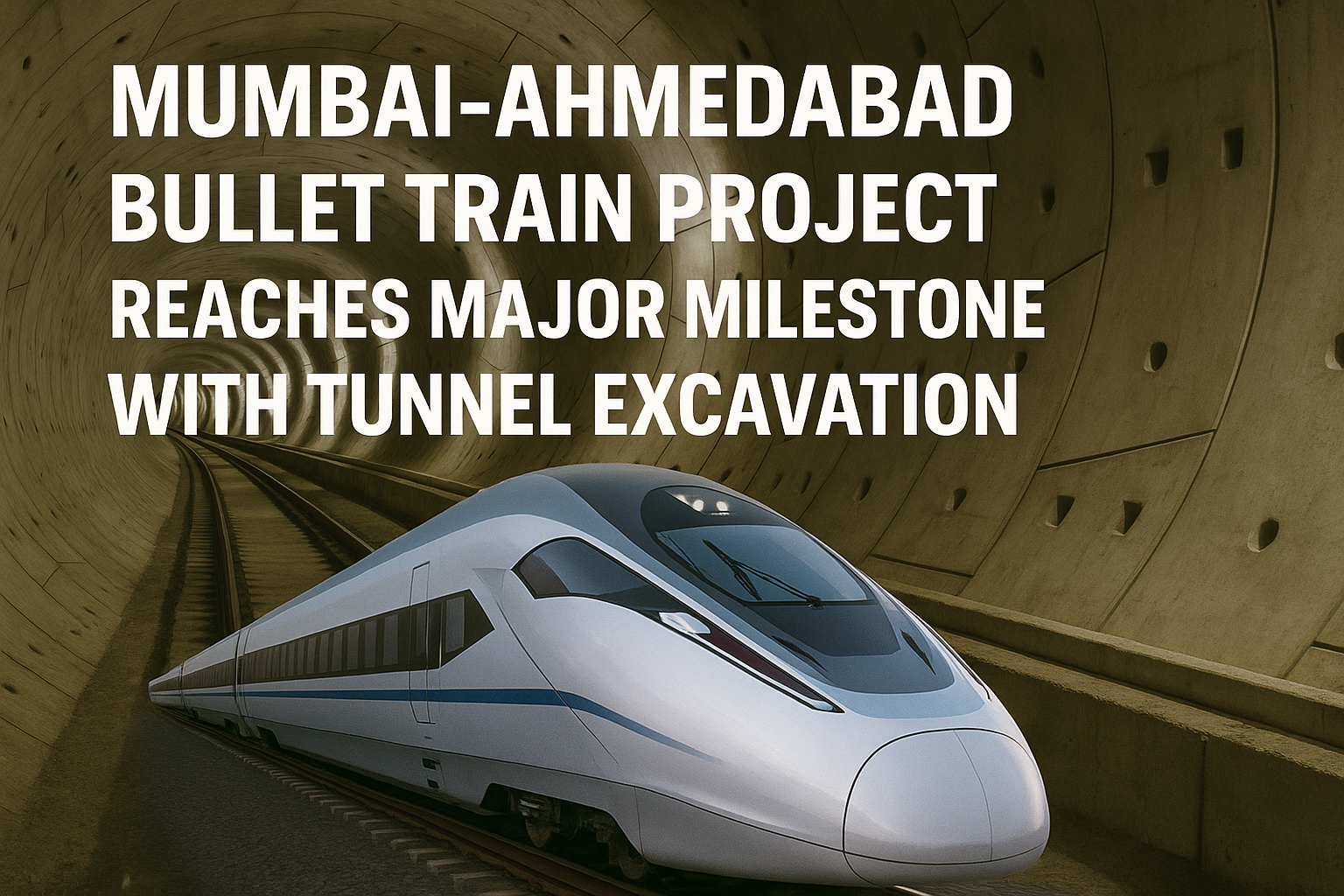
Mumbai-Ahmedabad Bullet Train Project Reaches Major Milestone with Tunnel Excavation
India’s first high-speed rail corridor — the ambitious Mumbai-Ahmedabad bullet train project — has added another achievement to its fast-progressing journey. Officials from the National High Speed Rail Corporation Limited (NHSRCL) confirmed that around 4.5 kilometers of the 21-kilometer tunnel between Bandra-Kurla Complex (BKC) and Shilphata has been excavated. This marks a crucial step toward the eventual linking of two of India’s busiest financial hubs with world-class transport infrastructure.
The excavation is being carried out using the New Austrian Tunneling Method (NATM), a modern technique that minimizes environmental disruption while ensuring precision and safety. The work has been simultaneously advanced from Shilphata and through two active faces from the ADIT (Additionally Driven Intermediate Tunnel) Portal in Ghansoli, Navi Mumbai. With nearly one-fourth of the tunnel length already completed, officials believe the pace of work is both encouraging and sustainable.
Beyond Mumbai: Progress Across Palghar & Gujarat
While Mumbai’s underground tunnel grabs attention for its engineering scale, the project is simultaneously moving ahead across different terrains. In Palghar district, excavation continues on seven mountain tunnels, with 2 kilometers out of a planned 6 kilometers already finished.
Meanwhile, in Gujarat, the progress is even more striking. Out of the 352 kilometers of alignment within the state (and Dadra & Nagar Haveli), the civil works have surged ahead:
Viaduct construction: 317 kilometers completed
Pier works: 396 kilometers done
Pier foundations: 407 kilometers achieved
Girder casting: 337 kilometers finished
Noise barriers — critical for reducing the environmental footprint of high-speed trains — are also being installed. Over 3.9 lakh panels have already been fixed across a 195-kilometer stretch in Gujarat. Track-bed construction too has crossed 198 track kilometers, and welding work for long rail panels of 200 meters each is actively in progress. More than 1,600 overhead equipment (OHE) masts have also been installed between Surat and Bilimora, covering around 40 kilometers of the corridor.
Stations as World-Class Gateways
The bullet train is not just about speed; it’s about reimagining passenger experience. Across Gujarat, eight stations — Sabarmati, Ahmedabad, Anand, Vadodara, Bharuch, Surat, Bilimora, and Vapi — are nearing completion. Structural work is largely done, and finishing touches such as interiors, roofing, and passenger facilities are underway.
These stations are being designed as more than just transit points. They aim to function as multimodal hubs, offering seamless integration with Indian Railways, Metro networks, buses, and other transport modes. Key hubs such as Ahmedabad, Vadodara, Sabarmati, and Surat are also being developed with dedicated parking zones to ensure convenience.
Inside, the emphasis is on comfort, sustainability, and cultural identity. Spacious lounges, childcare spaces, food kiosks, and retail outlets are being planned. Interiors will rely on natural lighting, skylights, and energy-efficient architecture. Green landscaping, solar panels, and rainwater harvesting systems reinforce the project’s commitment to environmental responsibility.
Mumbai’s Role in the Network
Back in Mumbai, the station at BKC — set to be the city’s first bullet train terminal — is witnessing steady construction. The base slab has been cast, while similar works are advancing at Virar and Boisar stations. These facilities are being built to international standards, designed to manage high passenger flow with efficiency and safety.
Mumbai’s role is vital, not just as the origin point of the corridor, but as the city that exemplifies India’s aspiration for world-class mobility. By reducing the Mumbai-Ahmedabad travel time to just over two hours, the corridor promises to reshape regional connectivity, business interactions, and tourism.
The Big Picture: Why It Matters
The Mumbai-Ahmedabad bullet train is not only a transportation project but also a nation-building exercise. It signals India’s intent to join the league of countries with high-speed rail networks. For commuters, it means faster, safer, and more predictable journeys. For cities along the route, it translates to new economic opportunities, jobs, and urban rejuvenation.
Perhaps most importantly, the project shows that complex engineering and infrastructure challenges can be overcome with coordinated effort. From tunnels under Mumbai’s dense cityscape to bridges across Gujarat’s rivers, every milestone reflects both technological prowess and administrative determination.
As an NHSRCL spokesperson put it: “These developments signal steady progress across multiple facets of the project, as India’s first high-speed rail corridor edges closer to completion.”
The bullet train is more than a steel-and-concrete structure — it is a symbol of velocity, ambition, and India’s future readiness. With one-fourth of the crucial BKC–Shilphata tunnel now complete, the dream of world-class rail travel in India is steadily moving from blueprint to reality.





